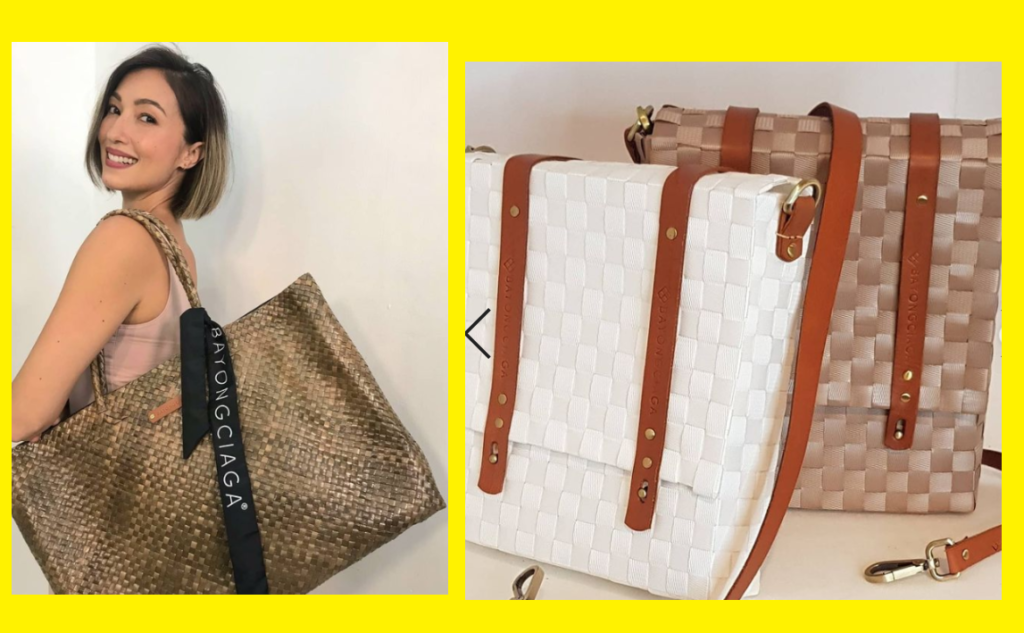
Bayong, the Filipino traditional bag made of weaved dried leaves, has truly evolved in recent years. Gone are the days when you can see it as this bag you usually use to hold your weekly groceries and supplies from your weekend trip to the supermarket. The typical bayong we can recall from our childhood days has chicly transformed fashion-wise. With its many variations in styles, colors, sizes and even functionalities, the traditional Filipino bayong has indeed become more than just an essential bag. It has become a fashion staple, with its obvious it-factor that can redefine and differentiate the identity of Filipino fashion– at least when it comes to purses.


In a Zoom interview, Javi shared how his trip to Pagsanjan, Laguna back in 2016 has changed the way he sees the Filipino bayong.
“I was eating halo-halo during my vacation in Pagsanjan when my eyes suddenly landed on this bayong displayed in one of the vendor stalls. I thought it was beautiful, colorful and just unique,” he said. “So I bought some for myself as I thought they could be cute book-holders at home.”
Javi shared some photos of his new “book-holders” on Facebook, and was shocked at the wild response he got from his friends and relatives. “Some were synthetic handwoven bags, while some were really made of authentic indigenous leaves from Laguna and they were all stylishly unique. Friends expressed their desire to order these bags from me, so from then on I decided to have short trips to Laguna whenever I could and buy as many bags from the artisans in Pagsanjan. From there, I saw the opportunity to help them sell and market the bags under our label name Bayongciaga.”
An owner of an advertising agency for more than a decade before that fateful vacay, Javi’s innate brilliance in branding, business development and marketing has effortlessly uplifted the imagery of the Filipino bayong, as well as its demand in the fashion market. Soon, Javier and his team have become more involved in design and product development, especially since they have later on started collaborating with ten groups of indigenous artisans from across the Philippines.
“In the province of Samar, we would help the local artisans by developing bags made of the area’s famous material called ‘Tikog’, which is a kind of sea grass,” the bag designer said. “For some bags, we would use ‘Pandan’, or coconut leaves from the province of Negros, ‘Inabel’ from Ilocos, ‘Banig’ from Panay, or bamboo materials from Palawan, just to name a few,” he said. “It has become an advocacy for us at Bayongciaga to provide livelihood to these groups of weavers and artisans from different localities across the Philippines.”
With prices ranging from ₱175- ₱2,500, it has become easy for Filipino fashionistas to embrace the modern bayong offered by Bayongciaga. The premium line is of course the most expensive collection, with its pandan premium bags accentuated with authentic Filipino leather, which then has empowered the leather crafting industry in Bataan.
“It’s been fulfilling for us that not only have we changed and modernized the traditional Filipino bayong and enriched the Filipino fashion business, but we’ve also helped many tribes and groups of weavers and artisans in different parts of the Philippines for them to have opportunities to earn more,” he said. “Bayongciaga has clients from different parts of the world, and that’s really humbling that even foreign fashion-lovers can appreciate our bags.”
Lockdown Transition: Bayongciaga Home
Just like any other businesses, Bayongciaga has struggled to keep up with the hard times caused by the global pandemic. But just like the resourceful and creative entrepreneur that he is, Javier has created ways for his label to still practically cater to people’s current needs.
“My main concern was the livelihood of the weavers and artisans, so I made ways for them to still have business. I geared the brand towards introducing home essentials, since people have been so creative on Instagram showcasing their lives at home– from buying and growing plants and flowers to boasting their elevated table-setting and dining aesthetic.”
“We decided to launch Bayongciaga Home, where we offer pots, organizers, placemats and other home decors and essentials made of weaved indigenous materials, so our artisans can still make a living,” he said. “Of course, we still sell our well-loved Bayongciaga bags.”
Going Global
As bag junkies and modern fashionistas can attest, Bayongciaga has indeed introduced the Filipino bayong in the global fashion market. From Paris, New York to London, you can always find a fashion influencer who’s so proud to don a chic Bayongciaga bag. Who knew bayong could be fashion-forward too?
“The Filipino bayong can be very adaptive to the times. It can always evolve with its various fluid materials, and we cannot deny its practical use. It can be wearable for everyday life, and can also be as high-fashion as you want because of its unique materials and design flexibility. The possibilities are limitless for the Filipino bayong. And I am happy that our label Bayongciaga has helped in uplifting our traditional Filipino bags in the global fashion scene by pushing the envelope in fashion creativity.”
When asked what would be his advice to aspiring fashion entrepreneurs, Javi has this to say:
“Find your inspiration- be it from social media, books, movies, travels or even window views. Creativity can be inspired by everything. Filipinos are creative. It’s all about nurturing your creativity and loving what you do.”
